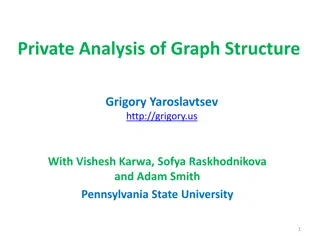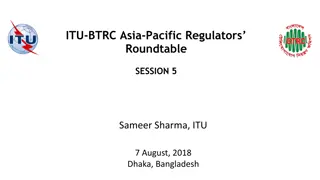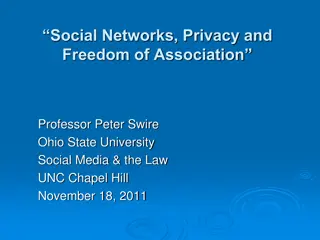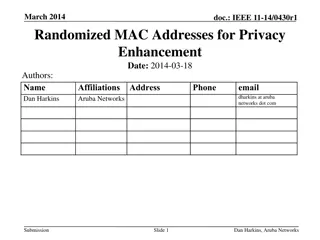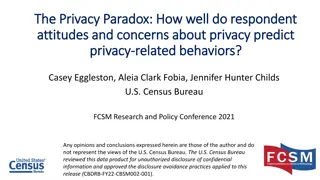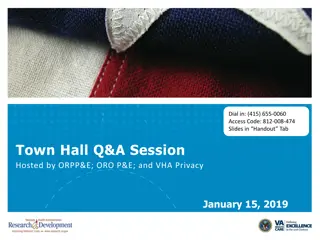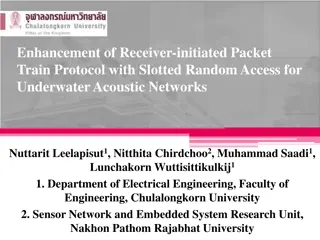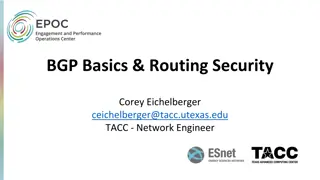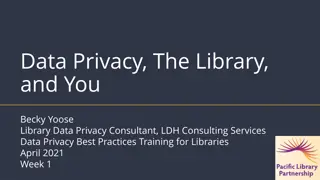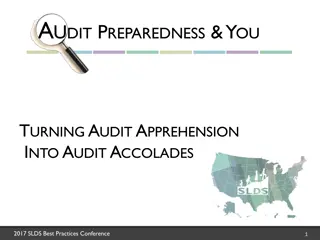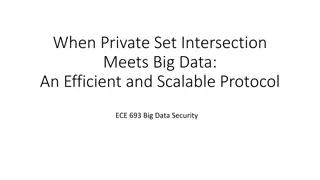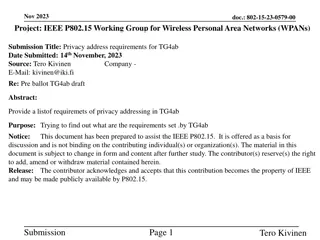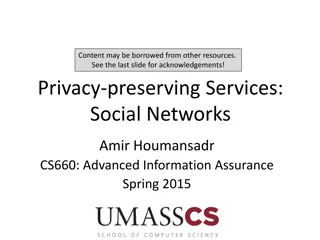Security and Privacy in 3G/4G/5G Networks: The AKA Protocol
This content discusses the AKA protocol in 3G/4G/5G networks, detailing the research background, academic journey, and ongoing projects related to security and privacy in network communications. It covers topics such as distance-bounding protocols, privacy-preserving databases, authenticated key exchange, and more. The talk focuses on authenticated key exchange, unilateral/mutual authentication, desired properties, privacy in authentication, and the implementation of the AKA protocol.
Download Presentation

Please find below an Image/Link to download the presentation.
The content on the website is provided AS IS for your information and personal use only. It may not be sold, licensed, or shared on other websites without obtaining consent from the author. Download presentation by click this link. If you encounter any issues during the download, it is possible that the publisher has removed the file from their server.
E N D
Presentation Transcript
SECURITY & PRIVACY IN 3G/4G/5G NETWORKS: THE AKA PROTOCOL WITH S.ALT, P.-A. FOUQUE, G. MACARIO-RAT, B. RICHARD
ME, MYSELF, AND EMSEC BSc. & MSc. Mathematics, TU Eindhoven Master thesis on multiparty pairing-based key exchange (supervisors: Tanja Lange, Bernhard Esslinger) Ph.D. at CASED (Darmstadt) Thesis: Security aspects of Distance-Bounding Protocols (supervisor: Marc Fischlin) Post-doc at IRISA (Rennes) 13- 14: Privacy & Distance Bounding (CIDRE) 14- 15: Privacy in geolocation (CIDRE/CAPPRIS) 15- 16: TLS/SSL (EMSEC)
EMSEC IRISA research team Founded 2014 Led by: Pierre-Alain Fouque (UR1) & Gildas Avoine (INSA) As of Sept. 2015: 5 permanents: 2 UR1, 2 INSA, 1 CNRS Topics: Embedded Security and Cryptography Design & Attacks Building blocks Models & Proofs Attacks on Implementation s Cryptanalysis Real-World ES
WHAT I DO Distance-Bounding Protocols Security framework [DFKO11, FO12, FO13b], Protocol assessment/comparison [FO13a, MOV14] Privacy-preserving DB [HPO13,GOR14, MOV14] Protocol with Secret Sharing [GKL+14] Implementations [GLO15] Authenticated Key-Exchange OPACITY [DFG+13] TLS 1.3 [KMO+15], TLS 1.2&1.3 ePrint version AKA [AFM+15, FMO+15] (submissions)
WHAT I DO (II) Other primitives Signatures of knowledge [FO11] Redactable signatures for tree data [BBD+10] Anonymous PKE [KMO+13] Private asymmetric fingerprinting [FGLO14] Projects ANR LYRICS [finished mid 14] CAPPRIS (Inria) [ongoing]
THIS TALK Authenticated Key Exchange Unilateral/Mutual Authentication Desired Properties Privacy in Authentication Elegant The AKA Protocol Description Security (intuition) AKA and Privacy The case of the Hopeless Task Ugly
PART II AUTHENTICATED KEY EXCHANGE
AUTHENTICATED KEY-EXCHANGE Allows two parties to communicate securely Peer-to-Peer or Server-Client Examples: TLS/SSL (https://) Two steps: Compute session-specific keys (handshake) Use keys for secure communication (symmetric AE)
AKE WITH UNILATERAL AUTHENTICATION Usually the case for Server-Client AKE Anybody can talk to the server Most common TLS mode Secure channel server/client or adv/server
AKE WITH MUTUAL AUTHENTICATION Sometimes server-client, mostly peer-to-peer Can also be achieved by unilateral authentication + password-based authentication in secure channel [KMO+15] Client and server confirm partner s identities
AKE SECURITY PROPERTIES (UNILATERAL) Key Secrecy [BR93], [BPR00], [CK01] : Adversary s goal: distinguishing the keys of an honest, fresh session from random keys of same length Rules of game: adaptive party corruptions, key- reveal, concurrent sessions and interactions Symmetric Key Restriction: no terminal corruptions! Client-impersonation resistance Adversary s goal: impersonate client in fresh authentication session Rules of game: adaptive party corruptions, key- reveal, concurrent sessions and interactions, no relays!
TERMINAL IMPERSONATION Terminal-impersonation resistance Adversary s goal: impersonate terminal in fresh authentication session Rules of game: adaptive party corruptions, key- reveal, concurrent sessions and interactions, no relays! The eternal debate: first or second Should terminal authenticate first or second? VANET, MANET, RFID authentication: terminal first When optional, usually terminal second
PRIVACY IN AUTHENTICATION DrawClient Corrupt Key Secrecy [JW00], [Vau07], [HPV+12] : Adversary s goal: find input bit to DrawProver Rules of game: DrawClient always takes same input bit, can corrupt*, interact, etc.
PRIVACY NOTIONS DrawClient Corrupt Weak : no corruptions Forward : once A corrupts, only corruptions (find past LoR connection) Strong : no restrictions Narrow/wide: know result of honest sessions
IMPOSSIBILITY RESULTS [Vau07]: Strong Privacy requires Key- Agreement [PV08]: Wide-Forward privacy with symmetric keys is impossible if all state is revealed*
PART III THE AKA PROTOCOL
PART III. 1 IDENTIFIERS & SECRETS
ELEGANT SYMMETRIC (A)KE [BR93] Usual case for AKE: 2 parties, e.g. client/server Share symmetric secret key ?? Sometimes public identifier ??? Elegant KE: use PRF keyed with ?? AKE? No problem, use another PRF and switch! ?? ???,?? ??? ??? ???? ?????(??,??)
THE CASE OF 3G/4G/5G Usual case for AKE: 2 parties, e.g. client/server In 3G/4G/5G networks, 3 parties: Client: registering with (only one) operator client key and operator key stored* in SIM Operator: has list of clients, whose data he knows Local terminal: not always operator (think of roaming) can authenticate/communicate with client must not know keys
THE CASE OF 3G/4G/5G (CONTD.) Some more restrictions: Connection Terminal Operator is expensive! Assumed to take place on secure channel Whenever PKI is used, in practice this means storing PKs and certificates in the phone No PKI for Terminals (too many of them)
1001 IDENTIFIERS Client associated with secret keys: ???,????,??? All clients of the same operator share same ???? Other identifiers: Operator associates ? with unique ??? (permanent) Each terminal ??associates ? with 4B ??? (temporary), unique per terminal, updated per session ??? ??? ??? ???? ??? ??? ???? ??? ??? ???? ???
1001 IDENTIFIERS (CONTD.) Each terminal has non- colliding list of ???s Inter-terminal collisions possible No centralized DB of all ???s Each terminal is associa-ted with unique ??? Like ZIP code (???, ???) unique
1001 IDENTIFIERS (SUMMARY) Multiple clients of same Operator ??? ??? ??? ??? ???
1001 IDENTIFIERS (SUMMARY) Multiple clients of same Operator ??? ??? ??? ??? ??? ???
1001 IDENTIFIERS (SUMMARY) ??? and ??? in protocol run, same ??? ??? ???, ??? ??? ???, ??? ??? Find ??? ??? ??? ?????? ??? ????, ??? ???? ???
1001 IDENTIFIERS (SUMMARY) ??? and ??? in protocol run, different ??? ???, ??? ??? ??? ??? ??? ???, ??? ??? ??? ???, ??? ??? ?????? ??? ????, ??? ???? Possible (not likely) ???? = ???
SECRET KEYS, SECRET STATE Client associated with secret keys: ???,????,??? All clients of the same operator share same ???? State ???is a sequence number Terminal also has a state ???? ?w.r.t. that client Used as shared randomness for authentication Initially randomly chosen for each client Then updated by update function (3 possibilities) Unlike ????,???, Terminals may know ???
PART III. 2 UNDERLYING CRYPTOGRAPHY
CRYPTOGRAPHIC FUNCTIONS The seven dwarfs: ?1 : used by terminal, for terminal authentication input (???,????,?,????? ?1 : used by client in special procedure input (???,????,?,????? ?,???) ?,???) ?2 : used by client, for client authentication input (???,????,?) ?3,?4 : used by both for session-key generation input (???,????,?) ?5 : used by terminal for blinding key input (???,????,?) ?5 input (???,????,?) : used by client for blinding key, special procedure
MILENAGE ?1 ?1 ?5 ?5 ?2 ?3 ?4
TUAK ?5,?5 ?2 ?3 ?4
WHAT WE PROVED FOR TUAK Single function ? generalizing the seven functions TUAK: ?????is PRF assuming that the internal permutation of Keccak is PRF Stronger than each function is PRF ! Intuition of ????? : use handy truncation of output
WHAT WE PROVED FOR MILENAGE Single function ? generalizing the seven functions Becomes 2 functions never used together in same call MILENAGE: ????,? ???are PRF assuming that the AES permutation is PRF Intuition of ????????? : use handy XOR-ing in all the right places
PART III. 3 THE PROTOCOL
AKA STRUCTURE (BASIC) ??? Initial Identificatio n ? ??? ???? Get ??? Handshak e ??????,???? Terminal Authenticatio n Check TAuth ? Client Check: d(???,???? Authenticatio n Resynch Procedure ?) ? Process Notify OK Update ??? Update ???? ?
AKA STRUCTURE (REAL) ??? Initial Identificatio n ? ???? Get ??? Handshakes ??????,???? ??????, ??????[???? ? ?] ??????, ???????[???? ?] ??????,???? ? Update ??? ??????, ??????[???? ?] OK ??????[???? ?] Update ??? Update ???? ?
INITIAL IDENTIFICATION ??? ID Request (???,??? ) Get ??? ??? Request ??? Fundamental privacy flaw: ??? easily obtainable! Security: even if ??? replaced, still OK (authen- tication automatically fails)
HANDSHAKE PREPARATION (1 BATCH) ??? ??? Set ??? = ??????[???? Generate R at random. ?] Compute: ?????= ?1???,????,?,???,??? ????= ?2(???,????,?) ?? = ?5(???,????,?) ???? = ??? XOR ?? || ??? || ????? ?? = ?3 ???,????,? ?? = ?4(???,????,?) Reveals Sqn ? and everything
TERMINAL/CLIENT AKE ??? ? || ??? XOR ?? || ??? || ????? Compute: ?? = ?5(???,????,?) Retrieve ??? and check ????? If ??? {???, ,???+ ?} Compute: ??? = ?2(???,????,?) ?? = ?3 ???,????,? ?? = ?4(???,????,?) ??? Check ??? = ???? Else Resynch!
RESYNCH PROCEDURE ??? If ????? verifies, but ??? out of range Compute: ?? = ?5 ???? ???,????,? = ?1 ???,????,???,???,? ???XOR ?? || ???? Compute:?? , get ??? Check: out of range Check: ???? Set ???? ?= ??? Start from there.
PART IV SECURITY OF AKA
SECURITY PROPERTIES Key Secrecy: Attained under assumption of pseudorandomness of ? Advantage is linear in number of clients! Client Impersonation: Attained under assumption of pseudorandomness of ? ?? ?? Advantage is linear in 2|????| and 2|???|
OFFLINE RELAYS ??? Initial Identificatio n Get ??? ? || ??? XOR ?? || ??? || ????? Initial Identificatio n ? || ??? XOR ?? || ??? || ?????
TERMINAL-IMPERSONATION RESISTANCE Attained as long as there are no offline relays Thus weaker than Client Impersonation guarantee Terminal Impersonation: Attained under assump-tion of pseudorandomness of ? ?? ?? Advantage is linear in 2|????| and 2|???|
PART V LACK OF PRIVACY & IMPOSSIBILITIES
TRUTH OR DARE 3 GPP claim AKA is: ID-Hiding nobody can identify client Location-hiding nobody can trace client location Untraceable nobody can link client sessions Their arguments: Nobody knows ??? and normally it is not used Sequence number and keys are hidden in transcripts We PROVE AKA is: NOT ID-Hiding very easy to recover ??? Location-hiding not really NOT Untraceable see some attacks next slide
DISTINGUISHING BY TERMINAL IMPERSONATION ??? Initial Identificatio n ??? Get ??? ? || ??? XOR ?? || ??? || ????? Initial Identificatio n ? || ??? XOR ?? || ??? || ????? DrawClient
DISTINGUISHING BY RESYNCHRONIZATION ??? Initial Identificatio n Repeat ? times Get ??? Update ??? ??? ? || ??? XOR ?? || ??? || ????? ??? Resynch! Initial Identificatio n ? || ??? XOR ?? || ??? || ????? DrawClient Get ??? Update ??? Clien t Auth
THE BIG IMPOSSIBILITY Goal: make this protocol forward-private Trivial solution: just build a new protocol How do we do it without changing it too much? The past kills your future In the AKA protocol the client is always one step behind the terminal/operator in state. Client corruption at time ? is enough to identify client in (? 1)st transcript Generalizable attack: problem is that 3GPP do not want the client to choose anything But we can fix the protocol to get weak privacy

 undefined
undefined






















